Col. Sudhir Farm

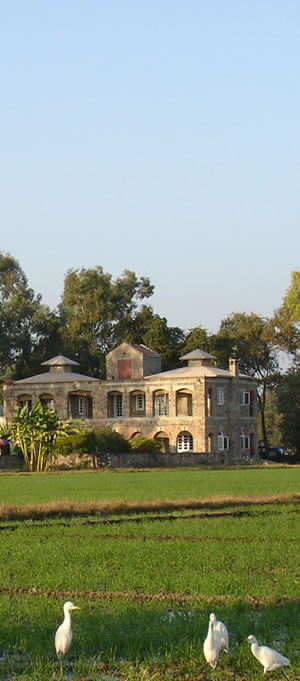


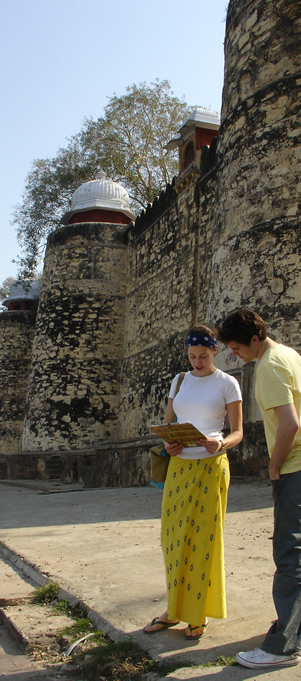

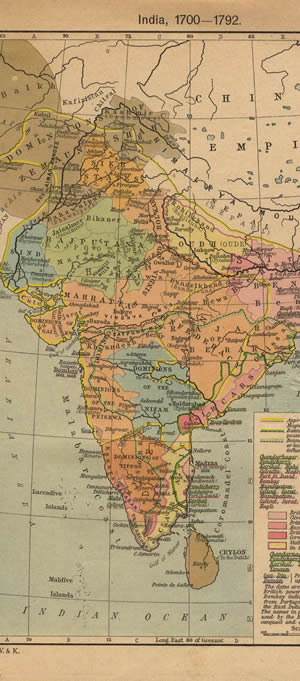
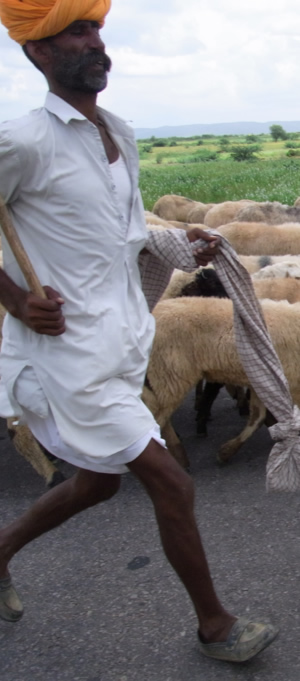
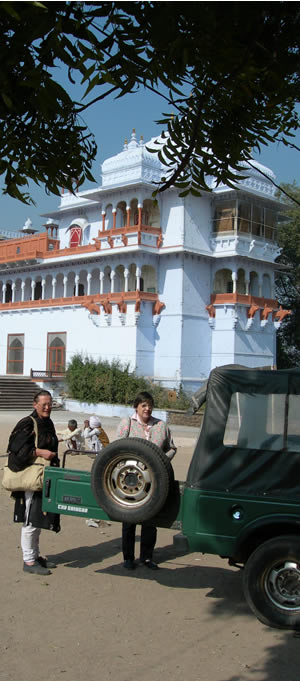
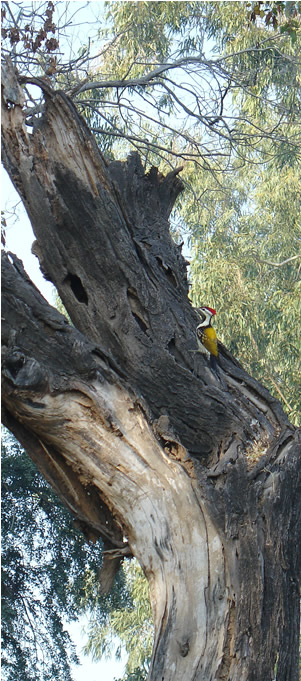
Snippets from the Visitors' Book
The Kota tonga trail was a real highlight - a bit like a 19th Century treasure hunt. It’s full of little nuggets of unusual information and fascinating glimpses into the unsolved mysteries of Kota.
Harriet and Will, London. UK
The memorial to Major Burton and his sons was much more moving than the Taj Mahal or the lake at Udaipur, marvellous as they are.
Henry Vane, Cumbria, UK
...the most comfortable bed I’ve slept in for 2 months....
Charlotte Adam, Winchester UK
Two days out of the noise and the people in a beautiful place. We felt totally
at home
- To be recommended to every person who wishes to experience the Indian country life. We also liked the way the food was prepared...
Patrick & Marie-Christine Lemaigre, Nil-St Vincent, Belgium
We’re only here for the porridge and home made bread! Thank you for a most wonderful time the memories of which we shall carry always. You have given us a wonderful & fascinating introduction to India.
Sue Turner, Lancashire, UK
So ...Rajasthan is not all desert! Thank you for sharing everything with us....
The Read family, London, UK
What a wonderful time we’ve had at the school in the village, at the weavers’, on the river, atop a tonga! Thank you for all your help and contacts throughout India
Anne Gerbner, Philadelphia, USA
It was a wonderful stay and thank you for giving us such a positive look at India and Rajasthan.
Salma Goldstein, New Jersey, USA
- There once was a lady of Kota
- Who took visitors out in her motor
- With the roads and the ruts
- It took quite some guts
- To go out with the lady of Kota.
- But once back at home on the farm
- The world quite descended to calm
- With the plants and the birds
- And fox terriers in herds
- There was balm in the calm on the farm.
Sue Millar, London, UK
After travelling around Rajasthan for two weeks, reaching a real house with books on the shelves, photos on the walls and four happy dogs was simply wonderful.
Camille Savinien, Paris, France
This isn’t tourism. I know of nowhere else where you can experience the real India as well as on your traditional working Rajasthani farm.
Sam Milward, Wellington, New Zealand
Thank you so very much for such a wonderful stay - what a fantastic introduction to India. I don’t think we’ll find such tranquillity elsewhere.
Lizzie Fortune, Hampshire. UK
Fabulous - I’ve been spoilt. It’s hard to leave and face the real world.
Elisabeth Simson, Isle of Wight, UK
After travelling around Rajasthan for two weeks, reaching a real house with books on the shelves, photos on the walls and four happy dogs was simply wonderful.
Camille Savinien, Paris, France
This isn’t tourism. I know of nowhere else where you can experience the real India as well as on your traditional working Rajasthani farm.
Sam Milward, Wellington, New Zealand
Thank you so very much for such a wonderful stay - what a fantastic introduction to India. I don’t think we’ll find such tranquillity elsewhere.
Lizzie Fortune, Hampshire. UK
Our visit at the farm was truly wonderful, off the beaten track it is a slice of India a visitor does not normally experience. Victoria is very knowledgeable about Indian culture and the people - an added perspective for us. The food here was very delicious: organically home grown ingredients, vegetables, fruits, grains prepared simply homestyle. A nice change from curries. Enjoyed the early morning boat ride and walk to the weavers. Many thanks.
Johanna Janssens, Washington, USA
I loved staying with you and the dogs and playing with the toys.
Jonas aged 8, Switzerland
A very welcome break from the crazy world of India – wonderful house, food and hospitality. Thank you so much.
Katie Buxton, Bath, UK
I loved seeing the crocodiles, and I learned a lot about deticking the puppies. Coming to the farm was a great experience.
Stella Bartholet, Washington, USA
A wonderful eye opening visit in every sense. We will be back! Thank you!
Christopher & Joanna Hobson, Northamptonshire, UK
A blissfully peaceful stay. We enjoyed everything – even the power cut. Thank you for lovely food, good company and very interesting trips.
Vicky Stark, London, UK
Exactly what we hoped for and more, bits of India off the tourist track, life as it actually is in villages, teeming life and livestock and the magic of the river.
Sir Hilary Miller, Worcester, UK
Thank you for the introduction to miniature painters, wall paintings, stories, great food, good company, walk through the fields. I loved the paintings in the City Palace and go back full of inspiration and memories.
Nan Mulder, Edinburgh, UK

On the Farm - 2017 Archive
On the Farm - December ’17
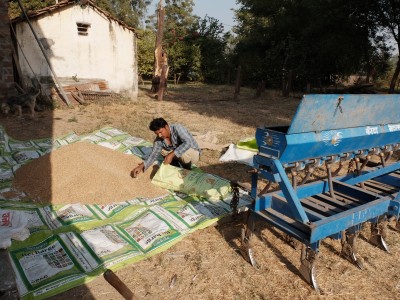
In December, having harvested the rice and sold it, we prepared the same fields for wheat. Here Vinod has mixed wheat seed (variety 4037) with equal quantities of DAP and is putting it into bags to fill the seed drill. These bags are opened flat and stitched into "tarpaulin" sheets known locally as tirpal, as you can see under the seed.
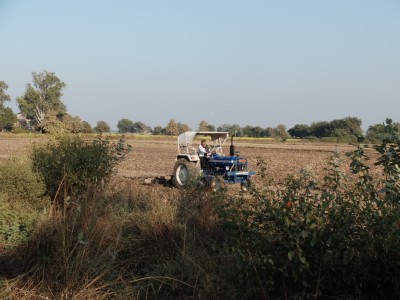
Wheat is being sown with mustard flowering in the background. The last wheat was sown before 14th December, having been delayed for a week by heavy rain on 5th December. This is the only rain we have had this month.
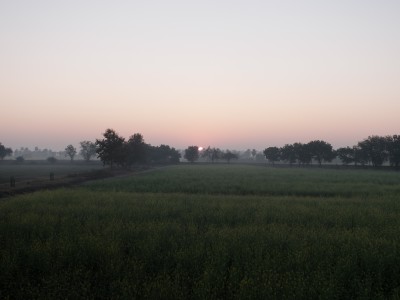
We had some beautiful misty sunrises with night temperatures around 11oC and daytime temperatures upto 29oC. The mustard was flowering all month and looks like a healthy crop. The rock bees, apis dorsata, were enjoying it but there are fewer hives to be seen hanging from the eucalyptus trees opposite the gate this year. This photograph also shows the southern-most point in the east at which the sun rises on the farm in the winter.
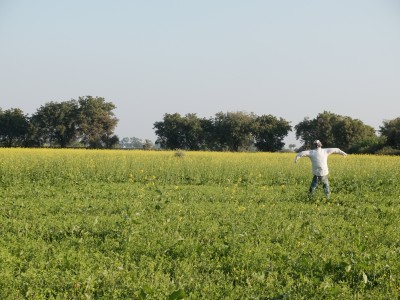
The main occupation, apart from watering the mustard, was cutting wild thickets, which provided shelter to our birds but also a haven for the destructive nilgai. They used to come and eat the green cow fodder or bersim every night, but once the wheat had sprouted, they left the bersim for our cows and munched our tasty wheat. This "scare-pig", as we call it, is standing surrounded by nilgai nibbled bersim.
We arranged for our men to do nightly patrols from 10pm to 12pm in return for two hours in lieu the following morning. We suspect that other employers are not so considerate. As it is, Vinod has two jobs and works in a village puncture repair shop from 6pm. He comes home for his dinner at 10pm and then has to patrol for two hours. The pigs are causing less damage this year since the boundary wall was built, but upto eleven nilgai have been spotted at night, their eyes glowing orbs in the torch light beam.
On the Farm - November ’17

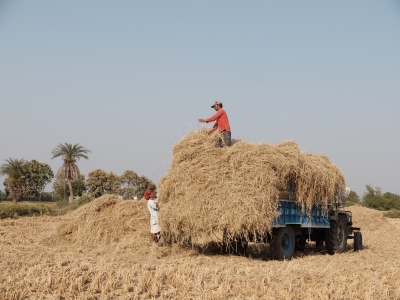
This year we harvested all our rice using a combine harvester as labour was in short supply. Once the rice had been cut by the combine, the rice straw was left scattered around the field. We wanted it for our cows so we paid two women to pile it up. The piles then were loaded into trollies by the men. It took several days to clear the fields.

There was still some straw left in patches, which ploughing would not have coped with and that was burnt. It is illegal but we were not burning the whole field. If we had sold the rice straw to some one else for their cows they would have paid very little for it as they would have had to pick, pile and load it at their own expense (hand cut rice straw is already in piles). Stubble burning is a huge issue. Delhi-ites blame the farmers who burn their stubble for high air pollution in Delhi.
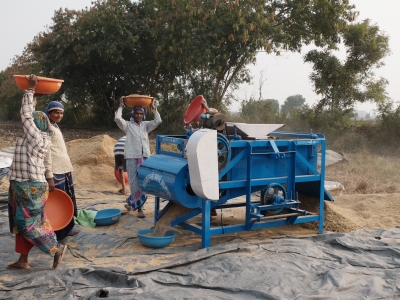
Most of November was taken up in dealing with rice. Our farm manager bought a new winnowing machine. He got his team of women to winnow the rice before loading the trolley. This was done to winnow out the empty husk so as to get a better price in the market - there was not much wastage. By drying his rice in the open for two weeks Ghansi Lal got Rs.2600 per quintal as compared to Rs.2000 for not so dry rice of an earlier batch.
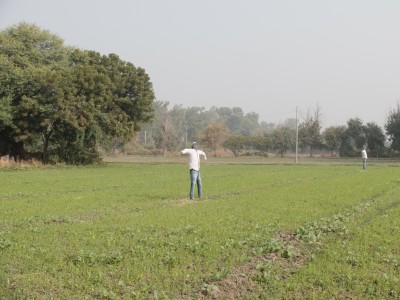
The rice fields had to be ploughed, watered and prepared for wheat. The bersim, or alfalfa, being grown for the cows was visited each night by marauding nilgai and pigs. Our men made these two scare pigs
using their own old denim jeans - a sign of prosperity.
We had our soil tested by a laboratory run as a free service for farmers by Chambal Fertilisers, a big local fertiliser producer. Our soil is balanced and in good heart but lacking slightly in sulphur, so we bought some sulphur granules and broadcast it before the final wheat field was sown. We should have put it before sowing the mustard as it increases the oil content but too late for this year.
It rained unexpectedly on 18th November and I took a sample of rain water and our open well water for testing. The rain water was better for crops as it had fewer salts, so we were told.
On the Farm - October ’17
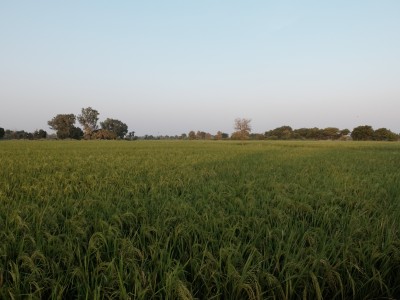
October was a hot dry month and our basmati type rice did well and started falling over under its own weight! We did not spray and the plants were healthy. Here’s a view of ripening rice taken on 7th October.
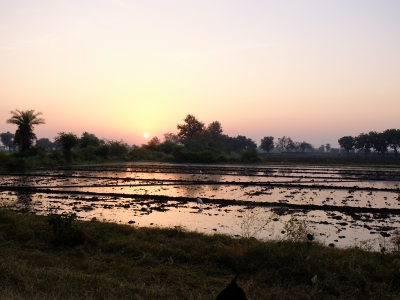
The fields that had had mung or urad or soyabean were ploughed, and the ones with soya bean were watered in order to sow mustard.
This year we sowed a very expensive hybrid seed called Pioneer 45S42 that cost Rs.490/kg as opposed to ordinary mustard seed produced in India costing Rs.30/kg. Last year we grew some of both varieties and the hybrid gave a much better yield. The ethical dilemma is that it is imported from America and is patented by DuPont in Iowa. By growing imported hybrid seed we are undermining India’s food security. We are searching for a high-yielding seed grown in India but ultimately the patents are held by American companies and every Indian sounding seed company has been taken over. This is a very serious matter and we shouldn’t be supporting it.
Sunrise over a field being watered befor sowing on 18th October just before Diwali which brings farming to a halt for three days.

Govardhan Puja took place as usual on the second day of Diwali, but the traditional decoration of the cows has degenerated into slopping mehndi on them and the gobar figures of Govardhan (Krishna) and his elder brother Balaram are getting smaller every year. The main purpose of the puja is to honour the cows as a source of wealth and to seek divine blessings on the farm and its cattle.

By the end of the month the rice was ready to harvest but we could not find any local labour. Some Biharis came asking for Rs.2400 per bigha to cut, stack and thresh the rice. We decided to use a new locally owned combine harvester at Rs.800 per bigha. It arrived on the evening of 26th October and the team of two slept out with the machine. They started cutting at 10:00am on the 27th and finished 10 bighas 5 hours later. As some of the rice had fallen over they charged Rs.1000 per bigha, a 25% increase. It was quick and efficient but left the rice straw scattered around the field.
The rice was spread to dry and was sold on 1st November. We should have dried it further as we potentially lost Rs.50,000 since it sold for Rs.2000 per quintal when the going rate was around Rs.2500. We weighed each trolley at the weighbridge and knew exactly what the weight of the crop was, but the Government grain market is a job creation scheme and it had to be bagged into 50 kg. bags manually. In the process we lost 171 kgs. i.e. Rs.3422 loss.
On the Farm - September ’17
September should be a monsoon month and it normally rains significantly until the end of the month. This year it rained once in September but we had the Father of all Storms overhead on 12th September and 6.5 cms fell in 1.5 hours. That was it. End of Monsoon - but it was hot and humid and everything grew.
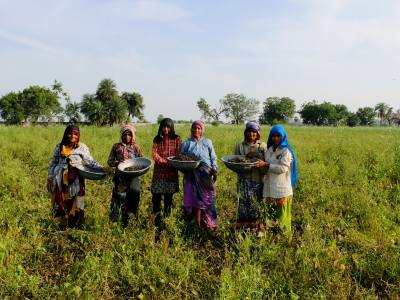
We had planted urad beans in 20 bighas but wild pigs, nilgai and monkeys did their damage to the crop, and change in weather pattern played its part too. 10 bighas was ploughed-in without harvesting and in the other 10 bigha field this team of six women came for three days and picked individual pods. The total yield turned out to be 19 kg. with an approximate value of Rs.760, far less than what we paid them but they wanted the work. A normal crop in 10 bighas would have yielded 710 kg.

Wall building went on all month and hopefully stray cattle incursions from that side will be stopped. Our men were regularly chasing cows out two to three times a day.
One of our men, Amar Lal, developed a fever which didn’t respond to treatment, so he took his son out of school and took his family back to his village for a month, where he was diagnosed with typhoid. No work means no pay. But extended families invariably support each other in such times.

On 25th September one of boring pumps stopped in the night. Ghansi Lal, our share cropper, found that the electric wire to the pump motor had been cut and it looked as if somone had tried to steal the pump. Several similar cases were reported locally that week and in all cases wire, rather than the pump, was stolen - presumably for the copper. It was an expensive business raising the motor with a jeep mounted rig and winch to attach new wire. This juggard arrangement was then welded over the boring to deter anyone coming to steal the pump-and-motor with easy pickings, as the thieves would know it had been lifted recently and would come out easily.
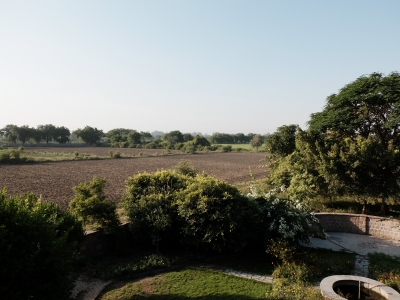
Since the land was not wet, we were able to plant our vegetable earlier this year and put in a large patch of maize, plus peas, guar, methi (fenugreek), coriander, beetroot, potatoes, tomatoes, aubergine, spinach, various gourds and pumpkins, and rocket.
By the end of the month the non-rice fields had been ploughed with no harvest from either soyabean or urad. All the women willing to work in the fields were busy planting or weeding rice and didn’t want to weed soyabean or urad. We didn’t want to use herbicides and allowed the plants to fix nitrogen as a form of green manure hoping for healthier and happier wheat and mustard in the winter. The cows were able to graze in each field as it was declared unfit for harvesting and their milk was excellent with thick rich cream.
On the Farm - August ’17
Despite what the BBC was telling the world, this part of North India has had a poor monsoon. We had heavy rain for two days on 7th and 8th, approximately 25 cms., but little for the rest of the month. But all is green and lush. The rice has needed to be watered constantly from the tubewell.
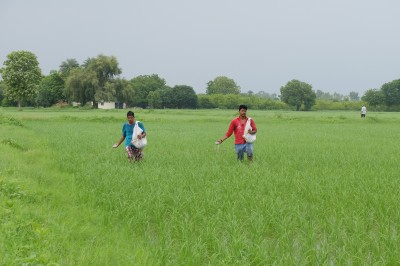
Here urea is being broadcast. Without it the growth would be very poor. We employed women to weed by hand and did not spray herbicide unlike on the rest of the rice on the farm which is share-cropped. The women were paid Rs.160 a day (approx. 1.95 GBP) to work from 10:00am - 6:00pm with an hour off for lunch.
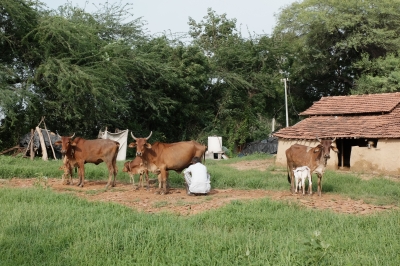
The cows have enjoyed being able to graze in the fallow fields and the soyabean fields. The non-rice fields had been sown either with urad or with soyabean. We decided to keep the urad but the soyabean was written-off and given over to the cows. We hope it has nitrogen fixed for the next crop.
Our three happy milking cows look at the camera for a photo op during milking. They produce about 8 litres of milk a day between them. In town people are paying Rs.60 per litre for cows’ milk but no one pays that here and we sell to the milkman for Rs.25 per litre. Once the urad is cut, the cows will live on the chaff.

The main event in August for Kota was the opening of the stayed-cable bridge across the gorge of the River Chambal. It is known as the ‘Hanging Bridge’ locally and was begun back in 2007. In 2009 the left river bank pier (left in the photograph) which was to support the cables collapsed suddenly and without warning, tragically killing 48 people. South Korea’s Hyundai, the Indian company Gammon and other agencies involved seemed to have sorted out the legal issues after the tragedy and finally re-started construction about two years ago. On 29th August the bridge was officially opened from Udaipur by Prime Minister Narendra Modi. With all heavy lorries now being made to go round Kota on the bypass and over the bridge, the traffic situation in Kota town has been transformed for the better.
The bridge is the final link in a major east-west route that connects North East India to Gujarat. And we can now whizz round towards Jaipur and Udaipur from our farm, avoiding Kota town entirely. This photograph was taken on a boat trip a few days before the inauguration. The high noise barriers on either side of the bridge mean that you cannnot see the river while driving over it. They also serve to deter people from jumping off the bridge and maybe from throwing litter into the river. The noise pollution preventative measures are also there for the wildlife below, as the bridge straddles a wildlife sanctuary.
On the Farm - July ’17

What a difference some rain makes. We had about 25 cms. of rain in July which is less than usual and was late coming. By contrast there was flooding in desert areas of S.W. Rajasthan
This field has been levelled and terraced. You can see the foundation for the boundary wall, being admired here by Anjelica and Lucy. By 19th July it was ready and was the last field to be sown with rice.

Soyabean and urad had been sown on 5th July and once the rice fields were flooded and the mud churned up or 'graded' the women transplanted the rice. You can see a JCB digging a trench for the boundary wall in the background.
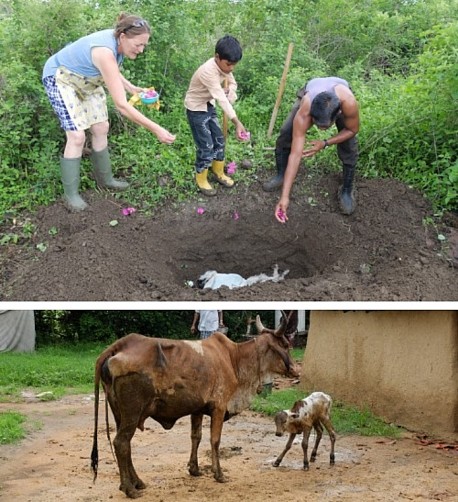
As July went on it became apparent that Anjelica, our white wire-haired fox terrier, was progressively becoming weaker. She was nearly 12 and the last of the fox terrier line we had founded with a breeding pair from England and Scotland. Anjelica died 21 years to the day we had arrived on 23rd July. One hour before her final breath a calf was born, the first for 5 months. We have called her Anju and she is white with brown splodges.
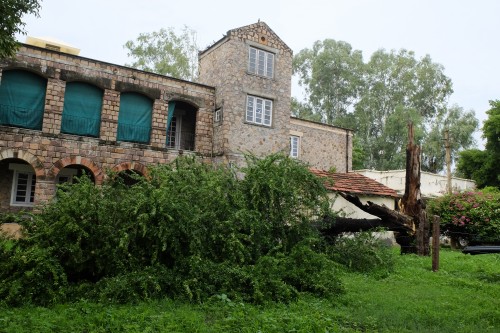
The other loss that anniversary weekend was the wood apple, Limonia acidissima which had been standing proudly in the jungle decades before our house was built. Local tradition says that a tiger was spotted under it in the 50’s. In the past machaans had been placed on it for hunting - but that was way before our time. The hollow trunk has been home to generations of spotted owlets. It stood in front of the house like a guardian.
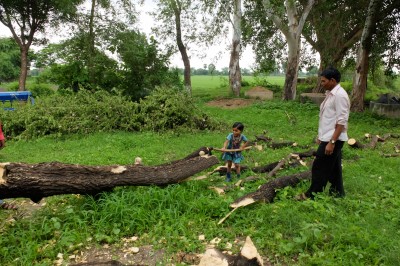
With no health and safety laws to worry about, 3 year old Ritu was able to use her father’s axe to try to split wood apples - they have a very tough outer shell. Forest School Indian style.
On the Farm - June ’17
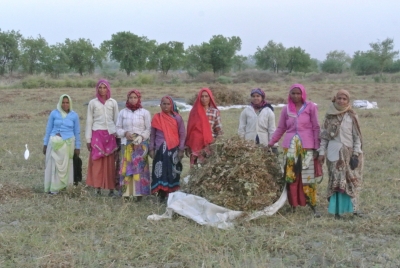 Very little rain in June until 22nd when 5.5 cms fell in one hour. The temperature remained at over 40oC all month and all construction and agricultural work went on regardless.
Very little rain in June until 22nd when 5.5 cms fell in one hour. The temperature remained at over 40oC all month and all construction and agricultural work went on regardless.
The boundary wall gradually lengthened to the east of us and to the west JCBs were widening the road and damaging our boundary hedge in the process. The road was blocked all month as a culvert was being built and a long depression that floods each monsoon was being filled in with truck loads of red soil and broken rock slabs. We were able to access the main road in the jeep using a little determination and ingenuity.
The women labourers walked to work so they were not deterred. Here they have cut and dried mung bean plants in small heaps and are about to gather them into larger piles for threshing. The yield was very low partly due to nightly foraging by nilgai while the watchman slept.
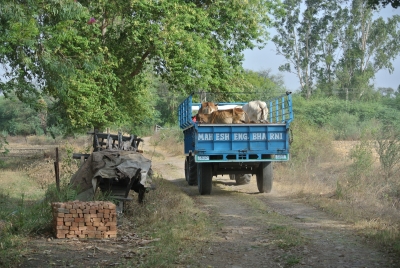
While searching for a new home for our surplus cows we heard of a new gaushala being run locally by a right wing Hindu party called Shiv Sena or Shiva’s Army. On the day that a newspaper article stated that the Government gaushala had run out of fodder for its 2000 heads of cattle, we delivered nine animals by tractor and trolley to the local gaushala. The following day we delivered another 3 thus halving the number of cattle we have to feed and look after.
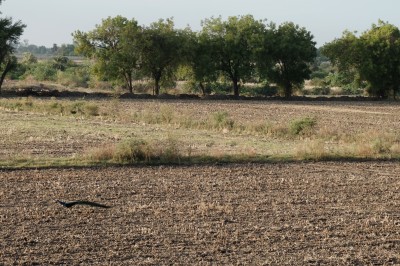
The final photo is a pre-monsoon view of the farm. You can see where the wall is being built. These fields will soon be green with soyabean.
On the Farm - May ’17

May was hot, very hot. Some days were 47oC. Work on the farm slowed down after two trolley loads of wheat were sold and work on the motorcycle shed could continue.
The Government support price of Rs. 1625 for 100 kgs. of wheat could only be realised by presenting documents of land ownership and land holding. The amount was then paid directly into our bank account. Agricultural income is tax free, but must be declared with other income, as it pushes the taxable income up. Farmers who wanted cash had to settle for the lower market rates.
During May the shed was roofed and tiled and the local joiner made doors and windows from locally sourced wood, mainly babool.
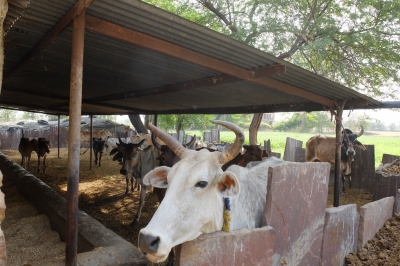
The cattle had to be fed during the dry season and with no chance of selling surplus animals as cattle trade has been banned, we were looking for a gaushala or ‘cow hospice’ to give them to. The Government one already had 2000 animals in it and was 20 kms. away.
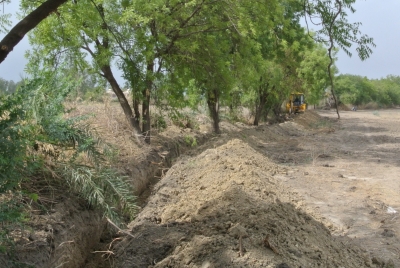
The main activity that started in May was the construction of a boundary wall along the eastern border of the farm where it adjoins Government property. They were building the wall.
First a JCB cut a 3-foot deep trench after consulting us as to how best to mark the actual border while conserving trees.
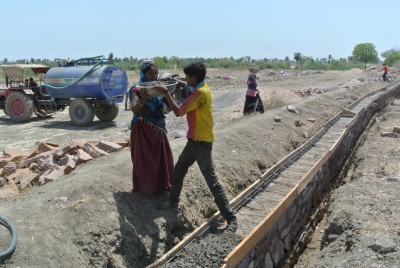
Labourers from Madhya Pradesh built the foundations. They work in pairs mostly with the women carrying head loads of soil, rocks or cement mortar and the men dealing with it.
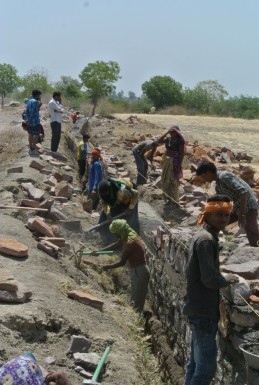
Once the foundation had been made and a solid layer of reinforced damp proof course laid on top, the wall went up above it.
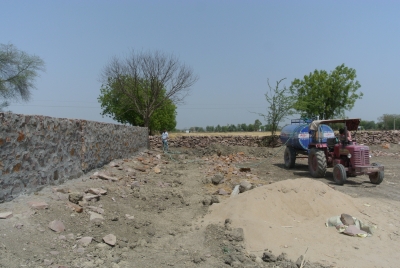
A tanker of water is there for construction, bathing and drinking purposes as it is fetched from a borewell. The new random rubble and concrete wall is on the left and a previous dry stone wall with no foundation or binding agent in the background.
The labourers worked on through the heat, but once the first monsoon rain had arrived in their village, they were keen to return home as soon as possible.
On the Farm - April ’17
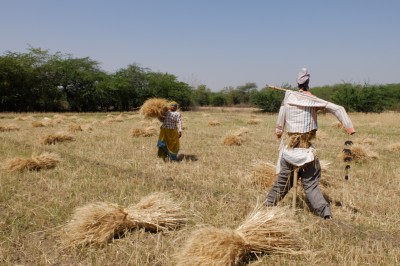
April is the wheat harvesting month. This year there was an abundant harvest everywhere with no untimely rain, hail or wind to ruin the crops.
Sita hand cut the heritage wheat C306 which we grow in a small area for home consumption. It has taller stalks, silky chaff and a very low yield but it has more flavour than modern hybrid varieties.

A combine harvester came to cut most of the wheat but 17 bighas (about 7 acres) was hand cut by a team of five women who were paid in wheat. They earned 75 kgs. per bigha between them. You can see hand cut bundles waiting to be threshed in the foreground and the combine in the further field.

Once the combine has cut the wheat there is a problem with the remaining stalks which are too long to be tackled by the disc harrow. They used to be burnt but that is no longer allowed - officially. One solution is this machine that cuts more of the stalks and chops it up for coarse cattle feed. Our cows don’t like it. We let the milkman take this boussa for his buffalos in return for paying for the tractor and cutting machine.
You can see a pile of boussa in the foreground from the hand cut and machine threshed wheat. This had to be filled into a trolley using large woven baskets and moved to the cowshed. Because of the heat the work was done on contract at night by a team of four men and a tractor driver. It took four 10-12 hour shifts to move 13 full trolley loads.

On 27th April after all the wheat had been heaped up we called the labourers to bag-up their share of the harvest. They then called gangs of youths with motorbikes to carry the 50 kg. bags. Each bike driver would have two bags behind him and an assistant perched at the back. Not a helmet in sight. They did not have more than a mile to go, though.
For 13 days work in the hot sun each woman earned wheat worth Rs. 324 per day or about 20 kgs. per day. The normal labouring rate is Rs. 200 per day for women.
We sold the wheat to villagers at the Government support price of Rs. 1625 or approximately 20 GBP for 100 kgs.
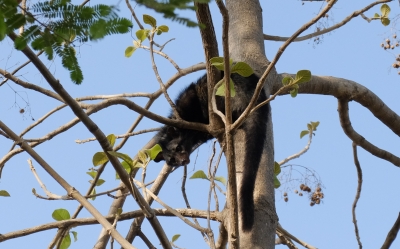
Our yields are less than others’ as we have to contend with monkeys, wild pigs and up to 7 nilgai (blue bull). This Indian civet cat came to within 50 metres of the house. It’s the first sighting in our 20 years living on the farm and we hope it got away safely unmauled by the dogs.
On the Farm - March ’17
March was notable for having the hottest March day ever in much of North India. On 29th March it was 43oC making us fear for the weeks ahead.

While the wheat was being watered, the mustard was being threshed. These women cut and threshed the mustard. The one on the left wears her husband’s trousers while working on the machine and then changes back into a sari to walk home. The one in the middle has a son with his own car but she works as a labourer to contribute to the household income; she may be paying her grandchildrens’ school fees? At least three women in the team are working with their daughters.
It has been a constant battle to prevent monkeys, wild pigs, four to five nilgais, and a herd of 20 local cows from eating our crops. One day we employed a young boy to chase out the cattle so that our men could get on with other work.
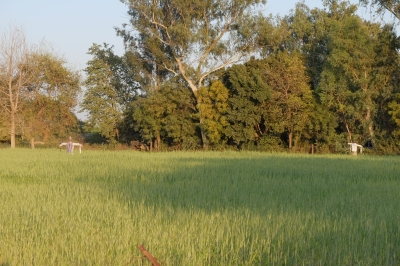
These ‘scare-pigs’ with musical chimes attached deterred pigs but not nilgai. This photo of our heritage wheat for home consumption was taken on 5th March.
The young calf being bottlefed (see last month’s news) did not thrive and must have had some other problems. He weakened and died on 11th March, two days before Holi. Even so we have too many cows and had to buy an expensive trolley load of rice praal (straw) to feed them.

The mustard bhoosa (dessicated straw and chaff) was sold, either for fodder or for using in factory furnaces; this team came daily for several days to load up. Once the fields were cleared, they were ploughed and watered and some were sown with mung beans for a summer crop. It will be a challenge to protect them from animals.
On the Farm - February ’17
February was a beautiful month with warm sunny days and cool nights. The main focus was on watering the wheat and from 16th February six women came to start cutting the mustard.
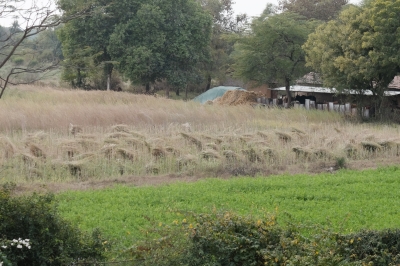
Since the crop is hand cut, greener patches can be left and cut later. Here bundles in the front have been cut and left to dry before stacking. The green fodder in the foreground is bersim for the cows.
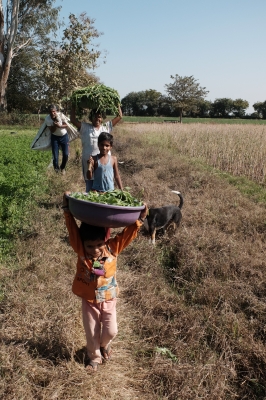
Large amounts of green fodder have to be cut every day for the milking cows and calves. Everyone can help - from the smallest to the biggest.

Three calves were born this month and this one always tried to suck at the front end of its mother and couldn't be taught to suck on the teats. He was happy to suck on a baby’s bottle though. The cow man said that it had ‘forgotten’ how to suck. Strange how the instinct for self-preservation seems to be absent.
On the Farm - January ’17
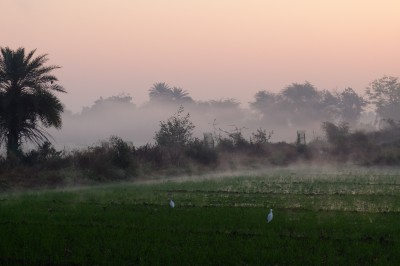
January is the coldest month and the night temperature dipped to 3.5oC one night which damaged some of the potatoes but was good for the crops. We had many beautiful sunrises with mist over the fields, particularly, as here, if the wheat had been watered.
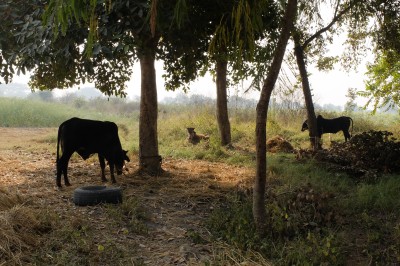
The main theme of the month is crop protection. Three separate bulls, having been cast out by their breeders, were taking refuge on our farm. However many times they were chased away, they forced their way back through the hedge. When impounded with the other cows they jumped out. Finally, they were herded into a walled cremation ground 1/2 km. towards Umedganj on separate occasions. They were brought back in a tractor trolley and tied-up. When all three were collected they were loaded up and driven away and released. This is ridiculous and non-sustainable, but they have no market value and can’t be sold or even given away.

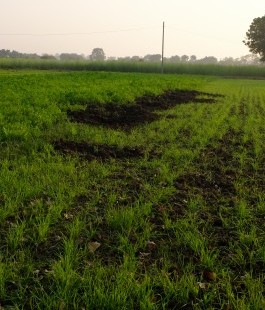
Pig damage is more difficult to deal with as there are more than thirty pigs coming daily and enjoying our wheat and berseem. The first photograph shows a group which could be seen from the house at 5:30 pm. The second photograph shows the damage that a small group of pigs can do in a night.
Two out of four dogs have been badly gored this month while chasing pigs but have recovered. As long as the dog can reach the slash to lick it there is no need for treatment. We have to be wary while walking with the dogs between mustard fields as an agitated pig could charge at us. So far so good. 'Speak softly and carry a big stick.'
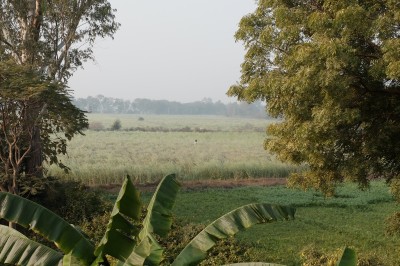
By the end of the month the mustard had finished flowering but lone male pigs and families of pigs could still hide in it during the day. Here a daylight pig hunt is on. The green in the foreground is the cattle fodder which they also love and the little ones can sometimes be heard squealing from the house!

